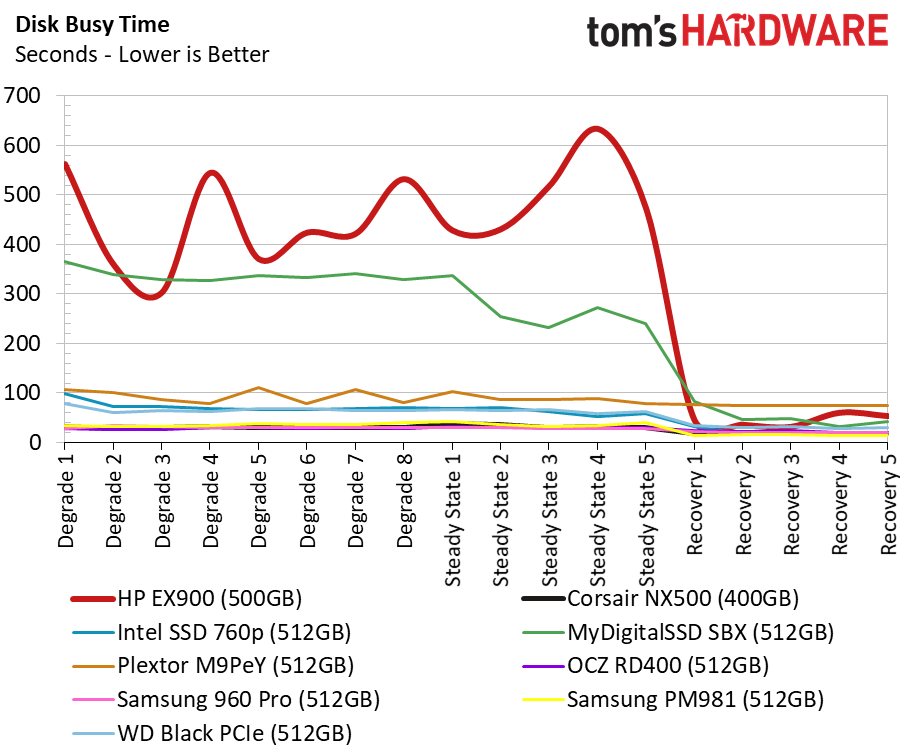HP EX900 SSD Review: HMB Makes DRAMless Better
Why you can trust Tom's Hardware
512GB Performance Testing
Comparison Products
The reference design SM2263XT SSD we tested in our preview article provided solid performance. As such, we didn't change our charts up too much to highlight the entry-level nature of the EX900, although we did add the MyDigitalSSD SBX. The SBX is another low-cost NVMe SSD, but it has a DRAM package.
The Intel 760p falls into the low-cost category even though the HP EX920 SSD costs less and delivers slightly more performance with the same controller and similar flash. The Samsung 960 Pro is a fixture in the ultra-high-performance market, but you'll have to spend more to bask in its performance. The Samsung PM981 has transformed from a unicorn to a popular OEM SSD that makes an appearance in several new notebooks.
The Corsair NX500 has just 400GB of usable capacity, while the Plextor M9Pe, Toshiba RD400, and Western Digital Black PCIe round out the test pool.
Sequential Read Performance
To read about our storage tests in-depth, please check out How We Test HDDs And SSDs. We cover four-corner testing on page six of our How We Test guide.
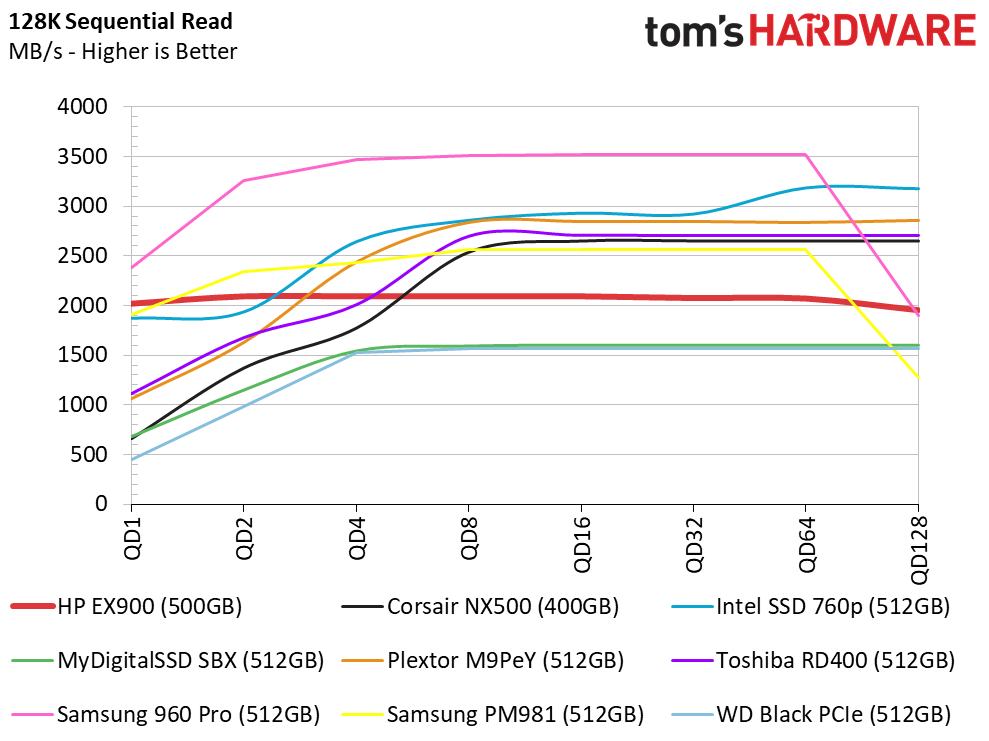

Most of the next-gen DRAMless SSDs we've tested don't scale well as we increase load. Instead, they are strong at low queue depths (QD), which is good considering the target market. The 500GB EX900 delivers a steady yet strong 2000 MB/s across the QD range, but it dips slightly under extreme load.
Remember, the EX900's goal isn't to be the best: it just has to be better than SATA SSDs at similar price points. The drive we're testing today reads sequential data nearly four times faster than many SATA SSDs.
Sequential Write Performance
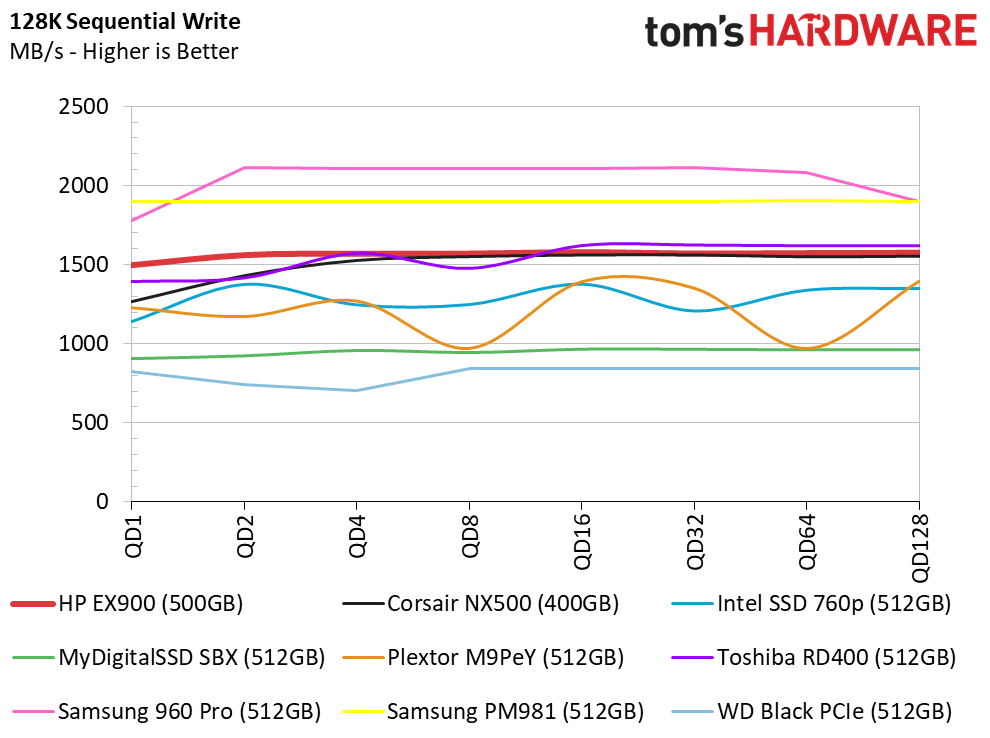
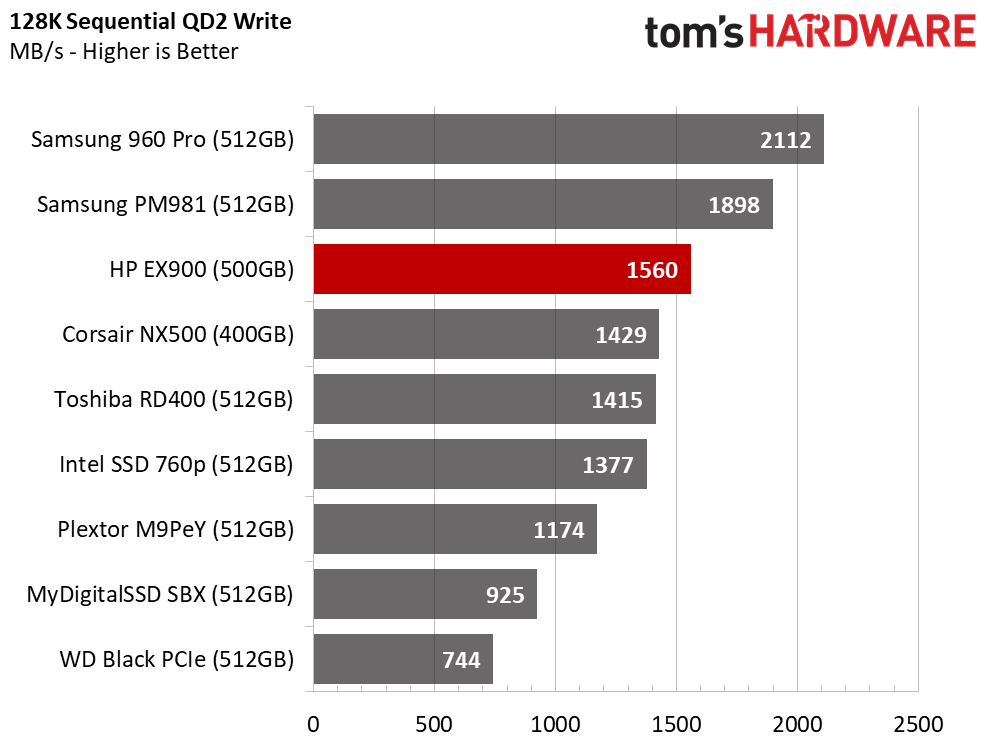
We measured the EX900's sequential write performance at a steady ~1500 MB/s. This is much higher than anyone could reasonably expect given its price point. This is a burst test though, so don't expect this performance over the long haul if you're writing very large files to the drive.
Get Tom's Hardware's best news and in-depth reviews, straight to your inbox.
Sustained Sequential Write Performance
The EX900 500GB does use a large SLC cache that spans around 15% of the overall capacity if you have very little data on the drive. The dynamic cache shrinks as you add data, but the 12GB of overprovisioning ensures you will have ample SLC cache for most file transfers.
Random Read Performance

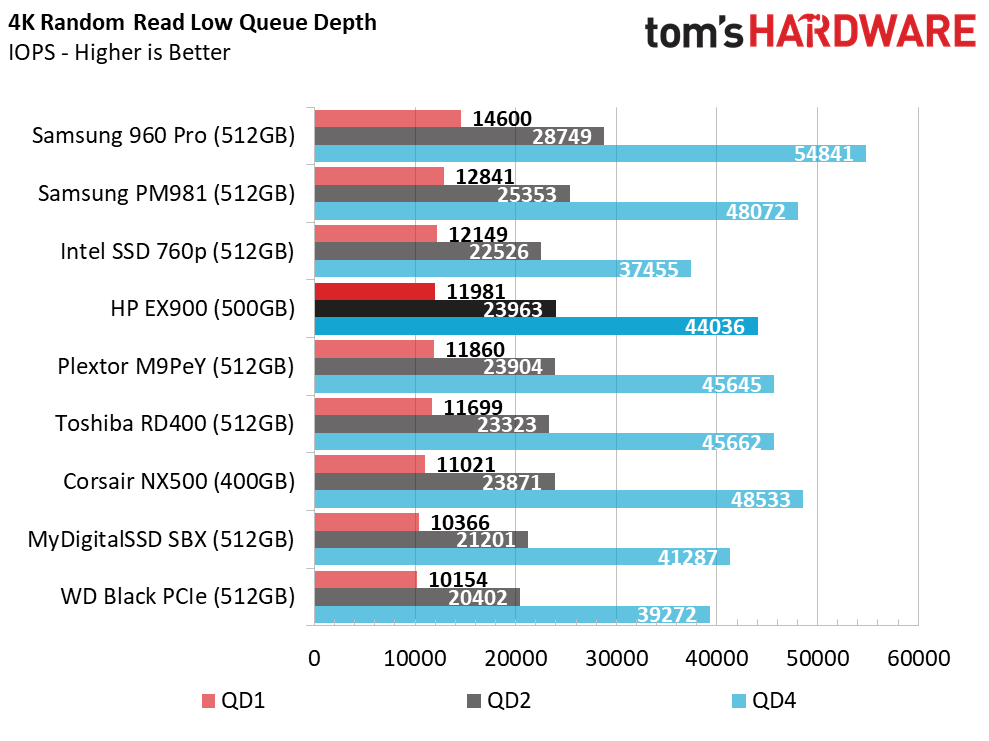
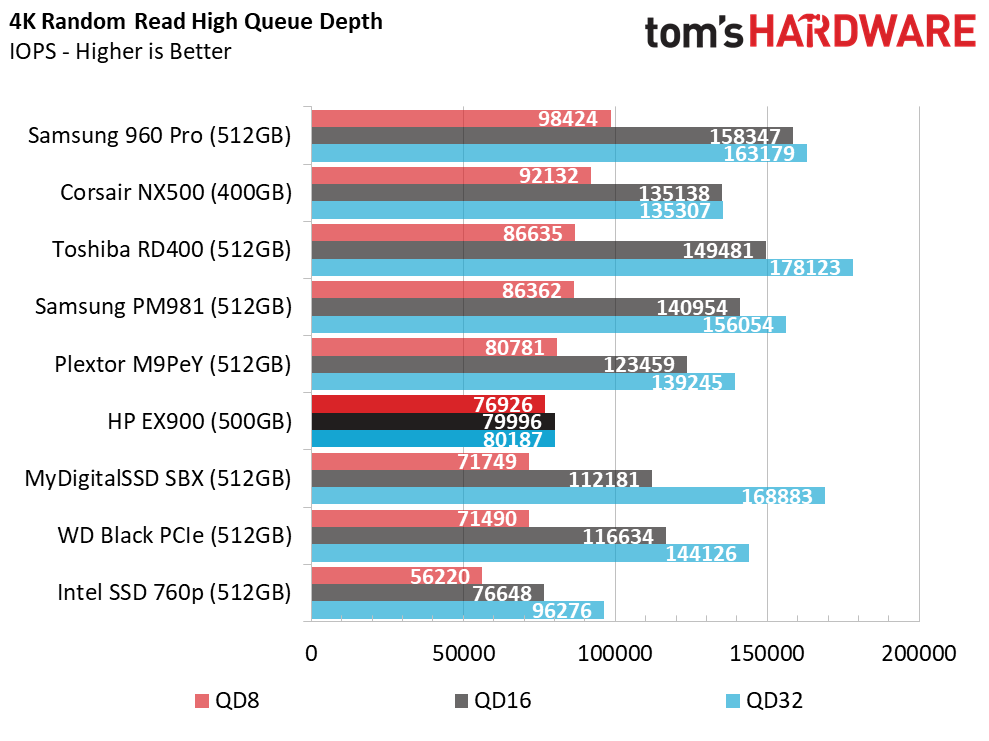
The DRAM-less EX900 performs well during random read workloads at low queue depths. The drive scored nearly 12,000 IOPS at QD1 and scaled well up to QD8. These are the most common depths for consumer workloads, so we're not as focused on the high queue depth range.
Random Write Performance



DRAMless SSDs always struggle in random write workloads compared to products outfitted with DRAM. The SM2263XT controller makes good use of the small SRAM cache inside the controller, which helps boost performance at low queue depths.
70% Mixed Sequential Workload
We describe our mixed workload testing in detail here and describe our steady state tests here.

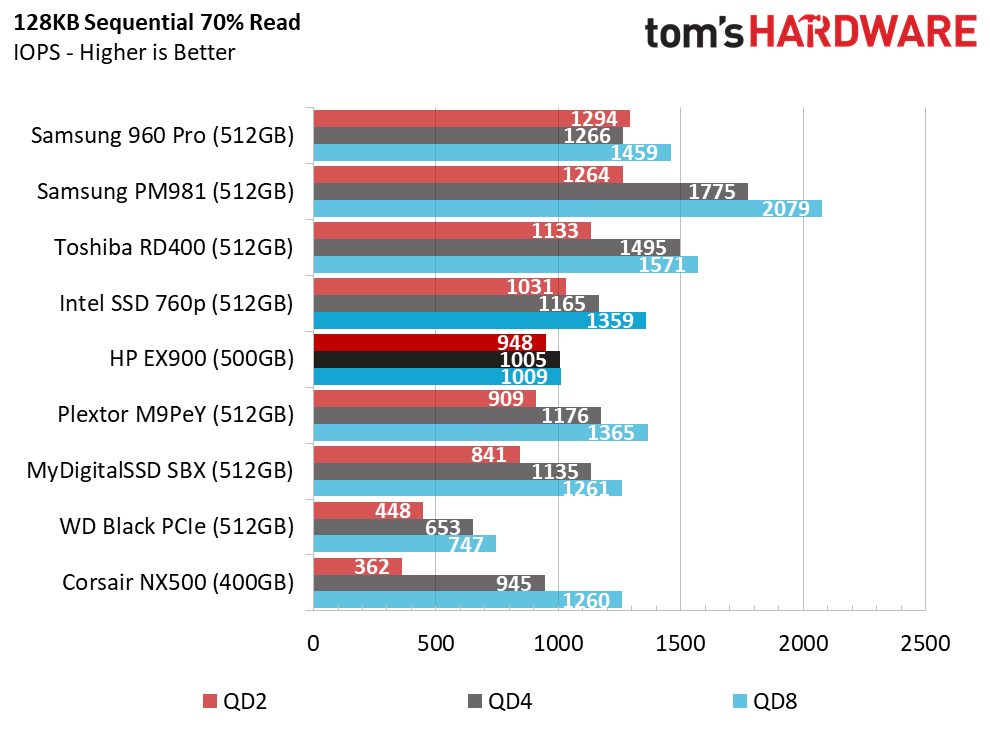
The EX900's mixed sequential performance holds steady at 1,000 MB/s throughout the test. The drive doesn't gain any performance as we ramp up the workload.
70% Mixed Random Workload


The same results also happened in the mixed random test. We're less enthusiastic about the results of this test, though. The sequential results are low compared to other NVMe SSDs, but the random results are even more out of proportion. The EX900 simply cannot scale as we lean on it with heavier workloads.
Sequential Steady-State
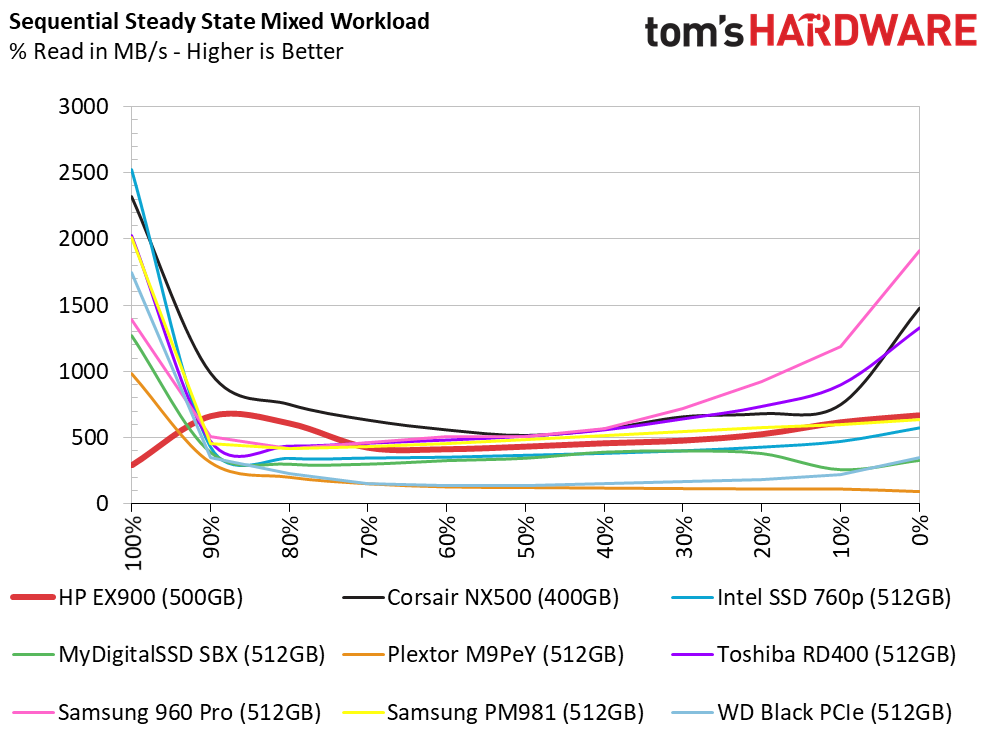
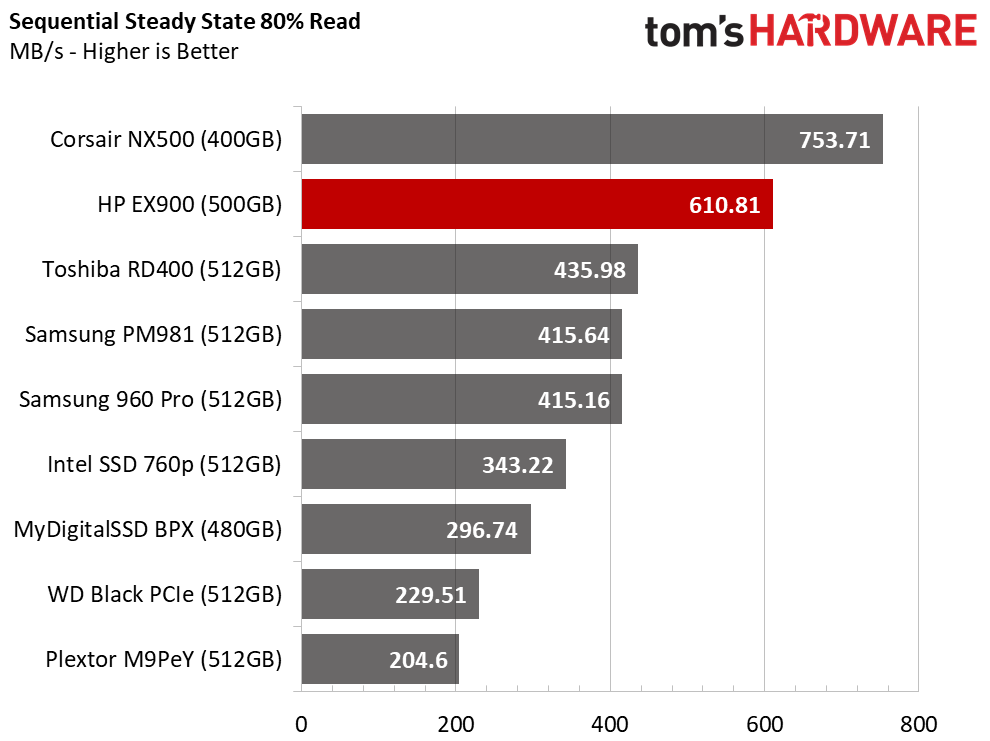

This drive wasn't built for heavy workloads. The low endurance rating will keep many enthusiasts and professional users from using it for heavy AV editing. The performance is surprisingly good in the two breakout tests, but you don't want to get this drive into a steady-state, which you'll see later in the review.
Random Steady-State


The random write steady-state test also brings another surprise. The drive is very consistent, but the performance is also very low due to the drive reaching out to the system RAM for the map of addresses.
PCMark 8 Real-World Software Performance
For details on our real-world software performance testing, please click here.






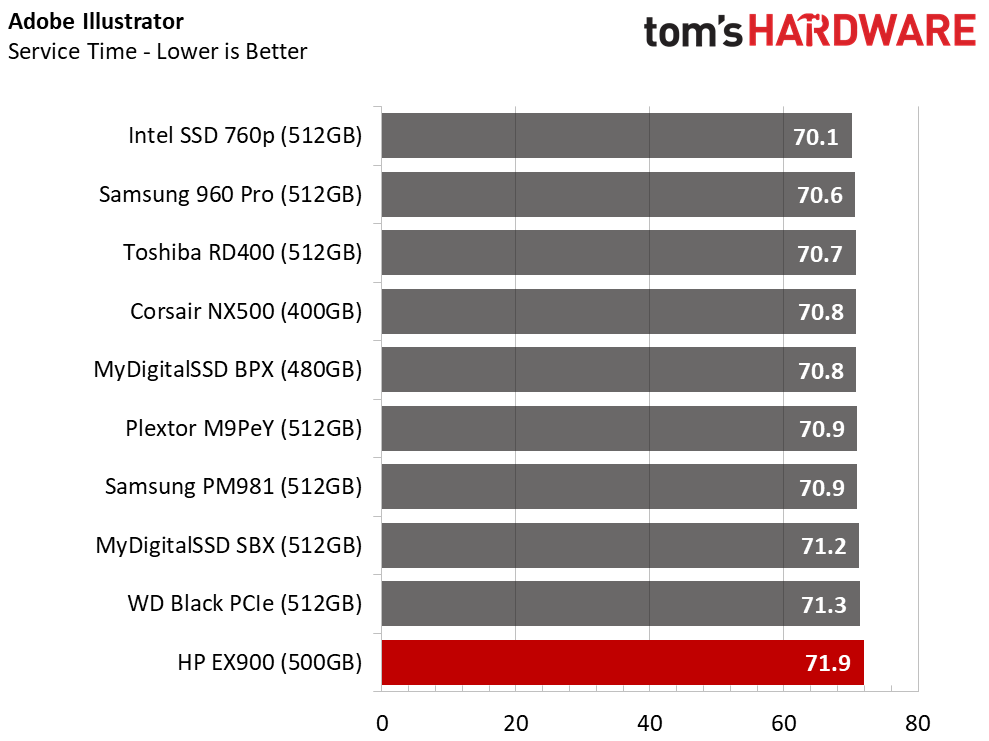



The EX900 doesn't win any performance contests with real-world applications. The drive doesn't have to either, as long as HP can get the price in line with SATA SSDs. Currently, the EX900's performance isn't in line with its pricing.
Application Storage Bandwidth
SSDs that use the Phison PS5008-E8 controller, like the MyDigitalSSD SBX, and variants from Kingston and Patriot, perform a little better than the EX900. The 512GB SBX currently sells for just $159.99 on Amazon, so it also costs less than the EX900. The Kingston and Patriot aren't as inexpensive as the SBX, so they don't provide the same value.
PCMark 8 Advanced Workload Performance
To learn how we test advanced workload performance, please click here.



As we mentioned, the 500GB EX900 falls flat during very heavy workloads. Unlike the EX920 we tested, this series does recover quickly after heavy workloads. The EX900 trails several of the other products during the recovery stages, but it's not the slowest NVMe SSD on the market.
Total Service Time



The EX900 has slightly elevated latency as it recovers from the heavy workload, but it isn't as high as the DRAM-less SATA SSDs of yesteryear. This represents a massive improvement for this product category.
Disk Busy Time
The disk busy time test shows us how long the HP EX900 500GB had to actually work to complete the workloads in each series of tests. During heavy use, the drive spends a lot of time pushing data to the waiting system. The EX900 responds much faster after a five-minute idle time because the controller has time to clean cells that are later used to write data at high speeds.
BAPCo SYSmark 2014 SE Responsiveness Test


The HP EX900's biggest competitor comes in the form of the Phison PS5008-E8 products, like the MyDigitalSSD BPX. The EX900 does provide a slightly better user experience than the MyDigitalSSD SBX. However, there are cheaper products that perform better than the EX900.
BAPCo MobileMark 2012.5 Notebook Battery Life
To learn how we test advanced workload performance, please click here.


DRAM is power hungry, and removing the chip makes a reasonable case for lower power consumption than DRAM-equipped SSDs. In fact, that was a big part of the initial DRAMless marketing push.
We found the opposite. The DRAM-less SSD do have lower idle and active power consumption, but in practice, the drives take longer to complete tasks, so they work longer. That means the drive spends less time sipping power at idle. DRAM-less SSDs also take longer to perform background activities, which is the work you don't see and very few actually measure. Garbage collection, which is one of the most prevalent background tasks, chews through a lot of power. That's why DRAM-less SSDs typically don't provide the power-to-performance ratio you would expect.
The EX900 does pretty well in our Lenovo Y700-17 gaming notebook. We measured more than five hours of battery life during MobileMark's test suite.
MORE: Best SSDs
MORE: How We Test HDDs And SSDs
MORE: All SSD Content
Current page: 512GB Performance Testing
Prev Page Features & Specifications Next Page Benchmark Results & Final Analysis
Chris Ramseyer was a senior contributing editor for Tom's Hardware. He tested and reviewed consumer storage.
-
cryoburner ReplyThe EX900 is a good SSD for casual users, but it has a pricing problem that needs to be addressed before we can recommend it.
Except "casual users" don't need an NVMe SSD, and would likely be better off paying less for a SATA one. In fact, I'm not convinced that most people will see much benefit from going with NVMe. Maybe things will load slightly faster, but it's questionable whether the real world performance gains are significant enough to justify paying 50-100% more for a given amount of storage. In my opinion, the biggest thing limiting SSDs right now is still cost for capacity, rather than performance, and SATA SSDs are a lot better in that regard.
And if the story here is that this drive is intended as an upgrade for SATA SSD users, it would be nice to see a SATA SSD included in the benchmarks. Of course, the SSD reviews here focus a bit too much on synthetic benchmarks anyway. Sequential performance at QD128 might be relevant to some very specific usage scenarios, but probably isn't useful for the vast majority of people shopping for SSDs.
And the "real world" benchmarks that are here all seem pretty terrible. If there's any performance difference between these drives, the PCMark 8 storage tests certainly don't show it. When nearly all the results are within 1-2% of one another, what exactly does that tell anyone about the performance of these drives? And how do these results even relate to what actual performance will be like in these applications? What specific tasks within the software is PCMark even testing? It's certainly not explained in the review, or even in the "How We Test HDDs and SSDs" article for that matter. Are they loading files, saving files? If so, what are the specifics of those files? With none of that explained, these "real world" benchmarks become little more than extremely abstract synthetics. How does something like 887MB of data read and 28MB of data written in Battlefield 3 relate to what actual load times might be like in that game? It results in 132 seconds of the drive doing something, but what? And with all the results from the slowest to the fastest drive being within 1 second of one another, how is that information even remotely relevant? Even the recently reviewed Crucial MX500 SATA drive averaged performance within 1% of this drive's results across PCMark 8's "real world" storage tests. If these tests are in fact representative of the real world, then there's little point in paying significantly more for NVMe for virtually identical performance. I'm sure there will be larger differences for things like bulk-copying directories of files within Windows Explorer, or installing software, but these reviews don't really provide any real world examples of that either.
Why not test some actual real world load times in applications and games? Load up a bunch of image files in Photoshop or videos in Premiere. Load up some levels in popular games, while using disk monitoring software to accurately track when the operation is complete. Test the time it takes Windows to load from a cold boot, or to return from hibernation. Install an application and run a malware scan. Such results would be far more representative of the real world than what PCmark's storage tests provide. And if the results still show no significant difference between a SATA SSD and an NVMe one in many of these common scenarios, then point that out. As it is, these reviews seem to do a good job testing synthetic operations, but the real-world tests are quite lacking. I get the impression that PCMark is being used for simplicity of testing, rather than providing any relevant results, and the fact that only a couple sentences are used to vaguely describe a drive's supposed performance across 10 applications and games should show how relevant the reviewer considers the results to be.
That process relies heavily on speedy DRAM, but memory is expensive. HMB technology allows SSD manufacturers to remove the DRAM on the SSD and use a small amount of your system memory (RAM) to achieve similar results. In general, a 512GB SSD will consume 512MB of system memory, but the dynamic cache grows based on the amount of data stored on the SSD. The amount of data used by HMB is a pittance compared to the amount of RAM in a typical system.
How much does 512MB of DRAM actually add to the cost of an SSD? Going by the cost of DDR4 system RAM modules, that works out to around $5 to $7 at retail, even ignoring the added costs of those modules. There will undoubtedly be other circuitry required for reading that memory on the drive as well, but I doubt that cutting out the DRAM is likely to save much more than $5 off the cost of a 500GB drive. It kind of makes DRAMless SSDs seem a bit pointless when removing the onboard memory likely only results in such a small price reduction. Maybe at the extreme low-end, when trying to shave a few extra dollars off a $50 drive it could be useful, but this isn't a $50 drive. Even the 120GB version is in the same price range as many SATA SSDs with double the capacity.
And as for the amount of system RAM being a "pittance", I would argue against that, at least for many usage scenarios. With RAM being expensive right now, many people building on a budget don't want to put more than 8GB into their system for the time being. For something like gaming, or many other usage scenarios where users are coming close to topping out 8GB of system memory, that can be significant. After accounting for the couple gigabytes used by the OS and background tasks, 512MBs could add up to nearly 10% of the memory available to applications and games. Sure, a user could move up to 16GB, but that will cost another $80-$100+, and most of that extra RAM probably won't be getting utilized any time soon in most systems. For someone with limited system RAM, paying an extra $5 or so for an SSD to have its own onboard memory could easily be the more reasonable option. -
HERETIC-1 Even with the high cost of RAM these days, I'm not convinced the savingReply
of a few dollars is worth it................... -
CRamseyer I wrote this article before the 970 series was available.Reply
"Why not test some actual real world load times in applications and games?"
I'm working on that now. -
Olle P Reply
My thought also. If the EX900 is meant to draw consumers from low end 2.5" SATA drives it would be suitable to have such drives in the comparison (and a regular HDD thrown in for good measure).20965816 said:... "casual users" don't need an NVMe SSD, and would likely be better off paying less for a SATA one. ...
Where I live (in Sweden) a low end 500 GB 2.5" SATA SSD is 8-10 times more expensive per GB than a 2 TB HDD.
The NVMe versions are some additional 20% up in price compared to 2.5".
Is the benefits worth it?
If you're low on space for another 2.5" drive, then sure, but that's rarely a problem. -
captaincharisma looks like HP is just like apple now where they expect you to overpay for their shoddy productsReply





